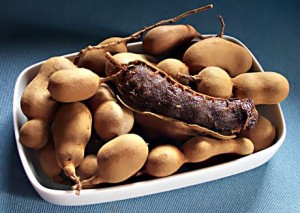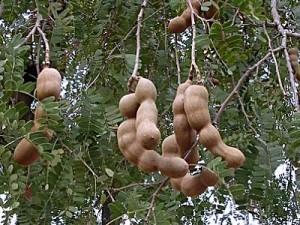Tamarind is one of the minor fruit crops in the Philippines with a great potential for commercialization. In the certain parts of the country, it is an important crop because its fruits and other parts have varied food and medicine uses.
In term of its export potential, the tamarind has great promise because its fruits may be processed into a number of acceptable products. But the mature and ripened tamarind of sweet type is said to be more important and expensive than when if processed. However, the supply still does not meet the demand.
The sweet tamarind has a number of disadvantages. It can be grown even in not-so-ideal soil, it is cheaper to grow and it is free from major insect pests and diseases that makes the tree almost chemical free. The tree is drought tolerant. Marketable fruits command a very high price in the market.
Production of Sweet Tamarind

Propagation
The tamarind may be propagated by seeds and by asexual means. Propagation by seeds is not advisable since the resulting plants are not true-to-type. This method is suggested in producing rootstock to be used for grafting.
Seeds are obtained from healthy and mature fruits are planted about 2 cm deep individually in potted soil rich in organic matter. A soil media with one-part soil, one-part rice hull and one-part compost is recommended. Seed germination is enhanced if part of the seed coat is removed or by dipping the seeds in hot water for few hours.
The seedlings should be watered constantly. Small amount of complete fertilizer (14-14-14) should be applied and insecticides should be sprayed if insect pest attack is observed.
For sweet tamarind, cleft grafting is recommended especially for large scale propagation. Rootstocks which are six months or older (about 0.6 – 1.0 cm in diameter) can be used for grafting. Scions (budsticks) having the same diameter as the rootstocks, which are fully developed, with mature leaves, the outer skin should be tender, not woody, and with well-developed buds are collected from full bearing trees of outstanding characteristics. After the scion is cut (about 8 – 15 cm long), the leaves should be cut-off immediately and then it is ready for grafting. Cover the union with the plastic bag (2 X 12 inches). Place the newly grafted plants under the shade. Keep the soil moist. In 3 -4 weeks, the scion will start to form shoots. Remove the plastic cover, cut back water sprouts regularly. Transfer them in open (full sunlight) area about a month after new shoots have developed.
Grafting can be done anytime of the year, but the best months are from November to May. If the budstick is not needed immediately, it can be wrapped in moist cloth, sealed inside a plastic bag and stored in a refrigerator for up to two weeks.
Planting/Transplanting
Clear the field of bushes and other unwanted vegetation. Prepare the land by plowing the field once and harrowing it several times until the soil is in fine tilth. Stakes are set following the desired distance of planting (8 -12 meters). Holes are dug about 30 – 40 cm in diameter and depth. Put at the bottom of the hole a mixture of old manure and topsoil. Set the plant such that the level of the soil in the bag is at the same level as the ground surface. Cover it with the mixture. The soil around the base of the plant should be packed firmly. Cover the soil around the planting hole with mulching material to help conserve soil moisture and control weeds.
Intercropping
Intercrop the tamarind with the short-season crops. In this way, income could be optimized while the trees are not yet bearing fruits. When trees have grown big and their branches begin to touch each other, intercropping should be stopped.
Irrigation
Water the plants immediately after planting and repeat as the need arises. Irrigation is beneficial especially for the development of flowers and fruits. To stabilize fruit production and quality, it is necessary to supply adequate irrigation during the dry season, and proper drainage during the wet season.
Fertilization
Fertilizer application is recommended to keep to keep the trees in healthy condition. Apply 200g of 16-20-0 and 50g of 14-14-14 per tree about a month after planting. The same amount is added at the end of the wet season. The amount of fertilizer is gradually increased as the trees grow.

Training, Pruning, and Fruit Thinning
Remove the very low branches and cut long upright shoots during the early years. For bearing trees, remove dead, and weak branches and shoots growing in wrong direction. Unpruned trees tend to have overgrown tops and produce crowded shoots. In a few years, the canopy becomes very dense. These should be trimmed into suitable shape, with an open center. In this way, the trees are easy to manage during harvesting as the bearing canopy covers a large surface area.
Fruits should not be allowed to ripen during the early years of bearing. Remove the flowers/fruits during its second, third, and fourth year. Fruit thinning in young trees will promote the growth of canopy. In mature trees, fruit thinning will improve the fruit quality.
Control of Insect Pests and Diseases
There are no major diseases of sweet tamarind. However, there are insect pests that were recorded which include the bagworms, mealy bugs, scale insects, leaf-feeding caterpillars, and green locusts. These pests are effectively controlled by spraying the trees with common insecticides at the recommended dosage.
Harvesting
The fruit may be harvested at half-ripe stage or full-ripe stage. The skin at half-ripe is easily peeled-off and the pulp is yellowish green. the pulp changes to brown and becomes sticky at full-ripe stage. Fully ripened fruits are determined by tapping with the finger. A hollow, loose sound is produced and the skin becomes brittle.
To harvest the fruits, it should be held in one’s hand and the other hand is used to cut the fruit stem. Harvested fruits are then placed in baskets or kaings. Usually, fruits are harvested from January to February for those trees which bear flowers in May or June.
Source: UPLB, Colllege of Agriculture